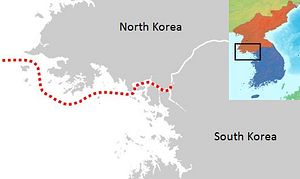That North and South Korea exchanged fire earlier this week raises concerns for the future of stability of the highly militarized Korean peninsula. My colleague Zach looked at the reasons events this week could lead to a destabilizing and dangerous “new normal” for the Korean peninsula. In contrast to Zach’s take, I thought I’d offer a more benign reading of the exchange. There are a few reasons to believe that this exchange of fire will end up being a minor blip longer term for relations between the two Koreas, and in that sense will be very different from other events like the sinking of the Cheonan which killed several South Korean seamen and the shelling on Yeongpyeong Island that also left Seoul bearing casualties.
The actual arithmetic of the skirmish demonstrates that the South exercised proportionality in its response to the North and the North refrained from escalating following the return of fire from the South. If neither of these aspects existed, the prospect for future instability on the Korean peninsula would be significantly higher.
The incident began with the North firing 500 shells into water on the southern side of the Northern Limit Line (NLL) – a territorial demarcation that Pyongyang rejects. South Korea responded by firing 300 shells from K-9 self-propelled howitzers and scrambled F-15 jets for patrol operations. These shells were also fired into the water. Further, no casualties were reported and the North notified the South of the “drill” by fax prior to firing (which doesn’t excuse the act by any means but significantly clears up the potential for the South thinking that the North was undertaking a serious offensive).
Preserving proportionality was a prudent move by the South and the only sensible way to respond. It reiterated to North Korea that its brazen provocations could not continue and that the South will respond in kind. Had the South shelled North Korean military assets, land, or any sort of critical facility, the situation would be significantly more worrisome.
Proportionality has its problems – most importantly, it is almost entirely subjective. While I might read the exchange as proportional and non-escalatory, North Korean commanders could have every reason to read the South’s return of fire as an escalatory measure. Given South Korea’s traditional restraint, North Korean commanders may have actually been surprised to witness return fire from the South. The subjectivity of proportionality did not cause problems in this scenario because neither North Korea nor South Korea actually took aim at or fired on any assets of actual value. Subjectivity is more a problem when a commander tries to determine how to respond following the loss of national assets – if North Korea had sunk a ship again or taken South Korean lives, a proportional response would have attempted to deprive the North of assets in return.
As Zach pointed out in his reading of the scenario, if anything the event highlights the implementation of South Korea’s new “active deterrence” policy, which attempts to put forth an assertive posture against North Korea’s continued provocations. “Active deterrence” offers legitimate causes for concern, particularly in terms of how South Korea might react to new North Korean nuclear provocations, but in general, this week’s events are unlikely to significantly transform the precarious situation on the Korean peninsula.

































